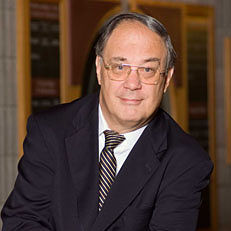- Areas of Interest:
- Applying organic analytical chemistry techniques to the analysis of trace levels of toxic pollutants, such as polybrominated flame retardants and polychlorinated biphenyls and pesticides, with a focus on understanding the behavior of these compounds in the atmosphere and in the Great Lakes

Education
- Ph.D., Analytical Chemistry, Massachusetts Institute of Technology, 1968
- B.A., Chemistry, Oakland University, Rochester, Michigan, 1964
Biography
With profound sadness, we report that Ronald Hites passed away on January 5, 2024.
Distinguished Professor Emeritus Ronald Hites was an environmental chemist specializing in the behavior of potentially toxic organic compounds. He had been with O'Neill since 1979, following 15 years at the Massachusetts Institute of Technology, where he received his doctorate in analytical chemistry.
Prof. Hites published six books, close to 500 scientific papers, and supervised about 90 post-doctoral associates and graduate students. Recent work involved the use of mass spectrometry to analyze trace levels of potentially toxic chemicals in the Great Lakes basin, including discontinued and alternative flame retardants, polychlorinated biphenyls, organochlorine pesticides, and polycyclic aromatic hydrocarbons. He also studied the atmospheric transport of these chemicals throughout the environment.
Prof. Hites was a Fellow of the American Chemical Society, the Society of Environmental Toxicology and Chemistry, and the American Association for the Advancement of Science. He received the 2016 Lifetime Achievement Award from the International Association for Great Lakes Research, the 1993 Founders Award from the Society of Environmental Toxicology and Chemistry and the 1991 Award for Creative Advances in Environmental Science and Technology from the American Chemical Society. He was an associate editor of Environmental Science and Technology from 1990-2018. In 1988, Hites spearheaded the creation of the Journal of the American Society for Mass Spectrometry while serving as president of that society. The Ron Hites Award is now given annually the best paper in that journal.
Highlights
- Indiana University Bicentennial Award (2021
- Associate Editor of the Journal of Great Lakes Research (2020-present)
- President, International Association for Great Lakes Research (2010)
- O'Neill Excellence in Teaching Award (2007)
- President, American Society for Mass Spectrometry (1989-1991)
- Institute of Scientific Information, a Highly Cited Author in Environmental Science or Engineering
Selected Works
- “Polycyclic aromatic hydrocarbons in the atmosphere near the Great Lakes: Why do their concentrations vary?”Environmental Science and Technology, 55, 9444-9449 (2021)
- “The rise and fall of chlorpyrifos in the United States,”Environmental Science and Technology, 55, 1354-1358 (2021)
- “Temporal environmental hysteresis: A definition and implications for polybrominated diphenyl ethers,” (with D. C. Lehman, A. Salamova, and M. Venier), Science of the Total Environment, 753, 141849 (2021)
- “Broad exposure of the North American environment to phenolic and amino antioxidants and to ultraviolet filters,” (with Y. Wu and M. Venier), Environmental Science and Technology, 54, 9345-9355 (2020)
- Elements of Environmental Chemistry, Third Edition, (with J. D. Raff), John Wiley and Sons, Hoboken, New Jersey, (2020)
- “Statistical approach for assessing the Stockholm Convention’s effectiveness: Great Lakes atmospheric data,”Environmental Science and Technology, 53, 8585-8590 (2019)
- “Identification of unusual antioxidants in the natural and built environments,” (with Y. Wu and M. Venier), Environmental Science and Technology Letters, 6, 443-447 (2019)
- “Break point analyses of human or environmental temporal trends of POPs,”Science of the Total Environment, 664, 518-521 (2019)
- “Tri(2,4-di-t-butylphenyl) phosphate: A previously unrecognized, abundant, ubiquitous pollutant in the built and natural environment,” (with M. Venier, W. A. Stubbings, J. Guo, K. Romanak, L. V. Nguyen, L. Jantunen, L. Melymuk, V. Arrandale, and M. L. Diamond), Environmental Science and Technology, 52, 12997-13003 (2018)
- “Atmospheric concentrations of PCB-11 near the Great Lakes have not decreased since 2004,”Environmental Science and Technology Letters, 5, 131-135 (2018)

